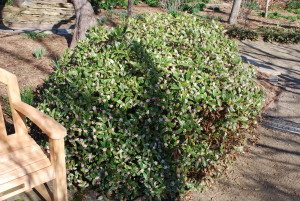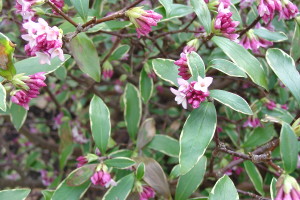Native to China and Japan, winter or fragrant daphnes (Daphne odora) open to light pink or white flowers in winter and early spring in the southeastern U.S. and Pacific Northwest (USDA hardiness zones 7-9). Their welcome floral fragrance will pervade through your garden for nearly two weeks starting in late winter.
Winter daphnes grow 3 to 4 feet high and spread. Flowers, mostly available in white and pink, are produced in small clusters on stem tips. When possible, place daphnes near a patio, deck or walkway where its floral fragrance can be enjoyed.
Glossy dark green leaves are leathery, evergreen, and vary from 1.5 to 3.5 inches in length. Variegated cultivars are edged either white or gold. On a rare occasion, plants bear fleshy non-edible red fruits which are few and far between.
Planting site must be exceptionally well-drained, be generously amended with compost, mildly acidic soil (pH 6.0-7.2), and kept adequately watered. Daphnes are notoriously finicky shrubs and don’t tolerate dry or poorly drained sites. Overwatering leads to their rapid demise. Plants also flourish in containers when properly cared for.
Set in one-half day, preferably in the early morning hours or in dappled shade. Daphne leaves will sun scorch when not adequately shaded. In warm climate zones, the further south you live, the plant should see less afternoon sunlight. Daphnes require only minimal pruning and spring is a good time, anytime after flowering.
Aphids and scale insects are occasional pests. Root rot, crown rot, and leaf-spots are fungal diseases, mostly caused by poor environmental growing conditions.
Leading varieties:
‘Aureo-marginata’ – rosy-pink flower buds that open to white with slight cream-colored edge leaves.
‘Alba’ – white flowering form.
‘Zuiko Nishiki’ – green leaves, heavier bloomer than species, more fragrant, and reportedly is hardier.



 Posted in
Posted in 
